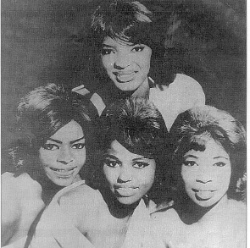This week we’re headed back to New York City after our sojourn down south. This week’s record is another of those one-of-a-kind, incredibly odd sounding records that somehow made its way into the public consciousness in the ’60s and has stayed there ever since. The Jaynetts hailed from the Bronx, and even though there are only three or four members featured in most of their publicity photos there were five members in the studio, together with a number of other singers, when “Sally, Go ‘Round the Roses” was recorded.
The origins of the Jaynetts go all the way back to 1954. It all began when a woman named Zell Sanders produced a record by a girl group called the Hearts called “Lonely Nights.” No major label wanted it, but it became a Top Ten R&B hit nonetheless when it was released by Baton Records in 1955. The income from the record allowed Sanders to start her own label, J&S Records.
It took a few years, but J&S finally had some national success with the Corsairs hit “Smoky Places,” which was released on the label’s Tuff Records subsidiary in 1961. Abner Spector, an A&R rep for Chess Records in Chicago put that deal together, and the following year he asked Sanders to assemble a girl group to cut a record. Spector’s wife Lona Stevens co-wrote “Sally, Go ‘Round the Roses” with Sanders for the occasion.
The group name came about by altering the middle name of Lezli Valentine, a J&S background singer who along with several other non-Jaynettes, including former Heart Louise Murray, sang on “Sally.” Valentine did become an actual Jaynett on subsequent group recordings. The credited Jaynetts for “Sally” were Yvonne Bushnell, Ethel Davis, Ada Ray Kelly and Johnnie Louise Richardson, who all had experience singing for J&S, and Mary Sue Wells who responded to a newspaper ad. The lead vocal was handled by another unofficial Jaynette, Justine “Baby” Washington.
 The arrangement for the record was by Artie Butler, and he later said that the credit on the record was all he ever got for his efforts. Butler also claimed that he played all the instruments on the record except for the guitars (played by Al Gorgoni and Carl Lynch), but there has always been a strong rumor that Buddy Miles was the drummer.
The arrangement for the record was by Artie Butler, and he later said that the credit on the record was all he ever got for his efforts. Butler also claimed that he played all the instruments on the record except for the guitars (played by Al Gorgoni and Carl Lynch), but there has always been a strong rumor that Buddy Miles was the drummer.
“Sally” was the only vocal track cut during the week of recording sessions. The B-side of the “Sally” was an instrumental version of the song which was credited to “Sing Along Without the Jaynetts.”
Spector never heard the track until it was finished, and when he did, he hated it. Then he played it for Jerry Lieber and Mike Stoller and when they offered to buy it from him he began to have second thoughts about the record. He decided to have the record released on the Tuff imprint.
The first place that “Sally” hit was in San Francisco, and the sound of the record can be heard as a major influence on the music that was to come out of that city in the next few years. When Grace Slick was in her pre-Jefferson Airplane band the Great Society she would cover the song regularly. On the east coast the record also had a profound effect on songwriter Laura Nyro.
“Sally, Go ‘Round the Roses” raced up the charts, peaking at #2 on the Billboard Hot 100 on September 28, 1963, and remaining there for two weeks.
The story, as if not confusing enough already, just gets more confusing from there. There were a number of follow up singles, featuring a variety of Jaynetts, on Tuff, including “Keep An Eye On Her” which bubbled under the Hot 100 in late 1963. During the following year Tuff released records by various people who had sung on “Sally” under group names like the Clickettes, the Endeavours, the Poppies, and the Patty Cakes.
Accounts vary about who played what, and who sang what, but one thing that is not in dispute is that “Sally, Go ‘Round the Roses” had a unique sound that would have a profound influence on the music explosion that would occur as the ’60s rolled on.





Comments